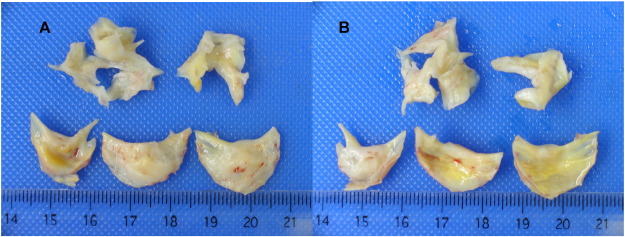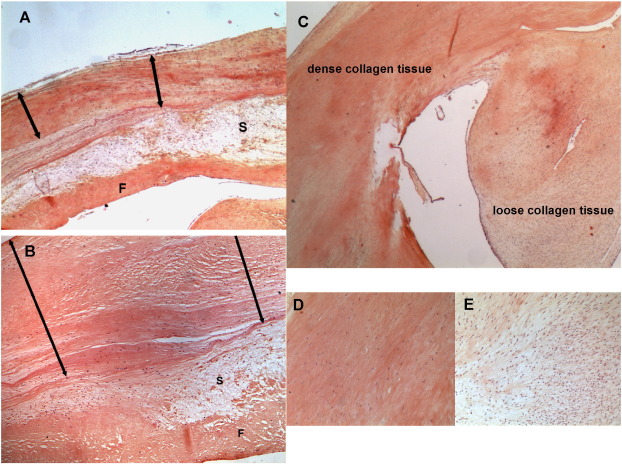(Created page with " ==Abstract== Patients exposed to benfluorex have an increased risk of restrictive organic valvular heart disease. Aortic and mitral regurgitations caused by fibrotic valve...") |
m (Scipediacontent moved page Draft Content 363413669 to Szymanski et al 2015a) |
(No difference)
| |
Latest revision as of 11:48, 19 May 2017
Abstract
Patients exposed to benfluorex have an increased risk of restrictive organic valvular heart disease. Aortic and mitral regurgitations caused by fibrotic valve disease are the most common features observed in exposure to fenfluramine derivatives in general and benfluorex in particular. We report here, for the first time to our knowledge, a well-documented case in which obstructive sub-aortic endocardium fibrosis within the left ventricular outflow tract is related with exposure to a drug that modifies the metabolism of serotonin. It now remains to be established whether extensive fibrosis of the myocardium in addition to well-documented valvular fibrosis may develop in patients exposed to amphetamine-derived drugs affecting the serotonin system.
A 67-year-old woman with dyspnea (NYHA functional class III) was referred to our cardiology department for mitral and aortic valvular heart diseases (VHDs). Her cardiac history included hypertension, dyslipidemia, type 2 diabetes mellitus and overweight. She has been exposed to benfluorex for eight years at 150 mg 3 times/day and has also received metformin, glibenclamide, aspirin, verapamil and furosemide. Her resting systolic/diastolic blood pressure and heart rate were 120/60 mmHg and 70 beats/min, respectively. Clinical examination revealed systolic aortic and mitral murmurs. Echocardiography revealed moderate left ventricular (LV) hypertrophy, normal LV ejection fraction and sub-aortic significant flow obstruction (peak velocity of 415 cm/s) due to septal sub-aortic hypertrophy without systolic anterior motion of the mitral valve. A moderately thickened aortic valve with a moderate central aortic regurgitation and a mitral valve thickening with shortening of the chordae tendinae leading to moderate mitral regurgitation without commissural fusion, both highly suggestive of drug-induced VHD, were found. Doppler estimated systolic pulmonary arterial pressure was 49 mmHg. The coronary angiography was normal.
The aortic valve and sub-aortic fibrosis were removed and an aortic bioprosthesis was inserted. Mitral valve repair was performed. Intraoperative findings included an unusual sub-aortic circumferential fibrosis stenosis (with no features suggesting congenital sub-aortic stenosis) and retraction of the aortic cusps. The macroscopic aspects of mitral and aortic valves but also of sub-aortic stenosis were highly suggestive of drug-induced fibrotic heart disease (Fig. 1). Both sub-aortic valvular and endocardial fibrosis were confirmed by pathological examination. Significant fibrotic thickening of the endocardium was found on the ventricular side of the aortic leaflets and featured dense collagen fibrosis and a low density of fibroblasts typical of drug-induced VHD (Fig. 2). The fibrosa and spongiosa were normal with no calcification and degenerative or rheumatic lesion. The fibrotic alterations of the sub-aortic sample (Fig. 2) in a histologic analysis were typical of drug-induced toxicity. The post-operative course was uneventful.
|
|
|
Fig. 1. Macroscopic appearance of the surgical specimens, with the two fragments of sub-aortic fibrosis (top) and the three aortic leaflets (bottom), centimeter scale. Left ventricular side (Panel A) and aortic side (Panel B). |
|
|
|
Fig. 2. Major fibrous thickening of the endocardium (arrows) on the ventricular aspect of the leaflet dense collagen fibrosis with low density of fibroblasts. The fibrosa (F) and the spongiosa (S) are normal without calcifications. Hematoxylin-eosin stain: original X 2.5 (Panel A) and X 5 (Panel B). Histological appearance of the subvalvular fibrotic tissue. Fibrous thickening of the endocardium, with abundant extracellular matrix and spindle cells X 2 (Panel C): this fibrous tissue is heterogeneous with dense collagen areas X 10 (Panel D) and loose connective tissue X 10 (Panel E). Hematoxylin-eosin stain. |
To the best of our knowledge, this is the first report of sub-aortic endocardium fibrosis within the left ventricular outflow tract related to exposure to a drug involving serotonin metabolism. Benfluorex is an amphetamine derivative related to fenfluramine and dexfenfluramine, marketed for patients with hypertriglyceridemia and diabetes mellitus but also used as an appetite suppresser [1]. It has been prescribed in many countries in Europe, Africa, Asia, Latin America and the Caribbean. Patients exposed to benfluorex as to fenfluramine present an increased risk of restrictive organic VHD. This risk is linked to the potent agonistic activity of norfenfluramine [1], a common metabolite of fenfluramines as well as of benfluorex. Aortic and mitral regurgitations caused by fibrotic valve disease are the most common VHDs observed in patients exposed to fenfluramine derivatives. The stimulation by these drugs of 5-hydroxytryptamine 2B (5-HT2B) serotonin receptor (found in both aortic and mitral valve tissues) upregulates transforming growth factor ß, resulting in glycosaminoglycan production and proliferation of fibroblasts and smooth muscle cells. The echocardiographic characteristics of drug-induced VHD have been thoroughly described [2]. There are some data in rodents to suggest that 5-HT2B receptors are present not only on heart valves but also in the non-valvular endocardium. Overexpression of the 5-HT2B receptor in the left ventricle of transgenic mice has been linked to left ventricular hypertrophy. Expression of 5-HT2A and 5-HT2B receptors has been reported in ventricular heart fibroblasts [3]. In rats, it has been clearly demonstrated that 5-HT2B agonists induce subendocardial cell proliferation especially in the left heart [4]. The biological result of activating such receptors is mitosis and secretion of inflammatory cytokines and extracellular matrix components [3]. These effects lead to cardiac hypertrophic remodeling, and, ultimately, impairment of ventricular function. One can legitimately hypothesize that serotonin has a direct, mitogenic, proliferative effect on cardiac non-valvular endocardial cells via 5-HT2B receptor expression. This endocardo-myocardial fibrosis might create left ventricular remodeling and diastolic dysfunction leading to heart failure in patients exposed to 5-HT2B agonist drugs. Thus, one case of restrictive cardiomyopathy was reported after fenfluramine–phentermine exposure [5]. In the present case, sub-aortic endocardial involvement responsible for severe non-valvular sub-aortic stenosis, considered to be related to drug-induced toxicity, was found in a patient exposed to benfluorex.
References
- [1] C. Tribouilloy, D. Rusinaru, S. Marechaux, A. Jeu, S. Ederhy, E. Donal, P. Reant, E. Arnalsteen, J. Boulanger, P.V. Ennezat, T. Garban, Y. Jobic; Increased risk of left heart valve regurgitation associated with benfluorex use in patients with diabetes mellitus: a multicenter study; Circulation, 126 (2012), pp. 2852–2858
- [2] S. Marechaux, D. Rusinaru, Y. Jobic, S. Ederhy, E. Donal, P. Reant, E. Arnalsteen, J. Boulanger, T. Garban, P.V. Ennezat, A. Jeu, C. Szymanski, C. Tribouilloy; Food and drug administration criteria for the diagnosis of drug-induced valvular heart disease in patients previously exposed to benfluorex: a prospective multicentre study; Eur. Heart J. Cardiovasc. Imaging, 16 (2015), pp. 158–165
- [3] J.D. Hutcheson, V. Setola, B.L. Roth, W.D. Merryman; Serotonin receptors and heart valve disease—it was meant 2b; Pharmacol. Ther., 132 (2011), pp. 146–157
- [4] M.R. Fielden, M. Hassani, H. Uppal, P. Day-Lollini, D. Button, R.S. Martin, R. Garrido, X. Liu, K.L. Kolaja; Mechanism of subendocardial cell proliferation in the rat and relevance for understanding drug-induced valvular heart disease in humans; Exp. Toxicol. Pathol., 62 (2010), pp. 607–613
- [5] R.E. Fowles, T.V. Cloward, R.L. Yowell; Endocardial fibrosis associated with fenfluramine–phentermine; N. Engl. J. Med., 338 (1998), p. 1316
Document information
Published on 19/05/17
Submitted on 19/05/17
Licence: Other
Share this document
Keywords
claim authorship
Are you one of the authors of this document?

